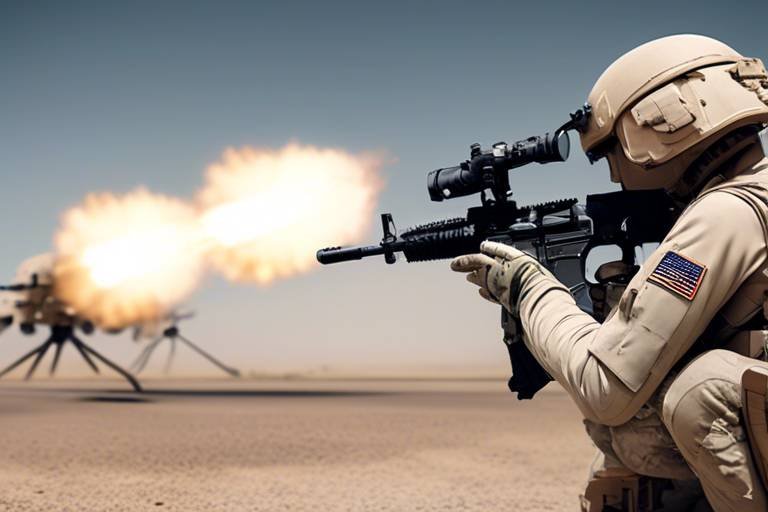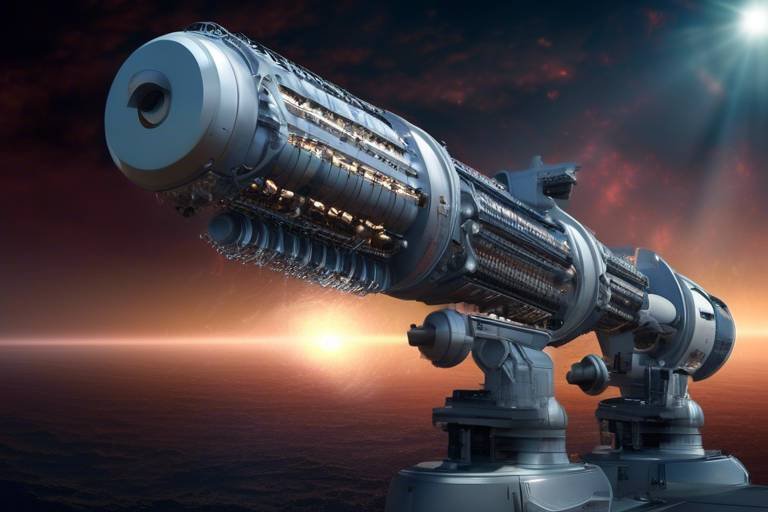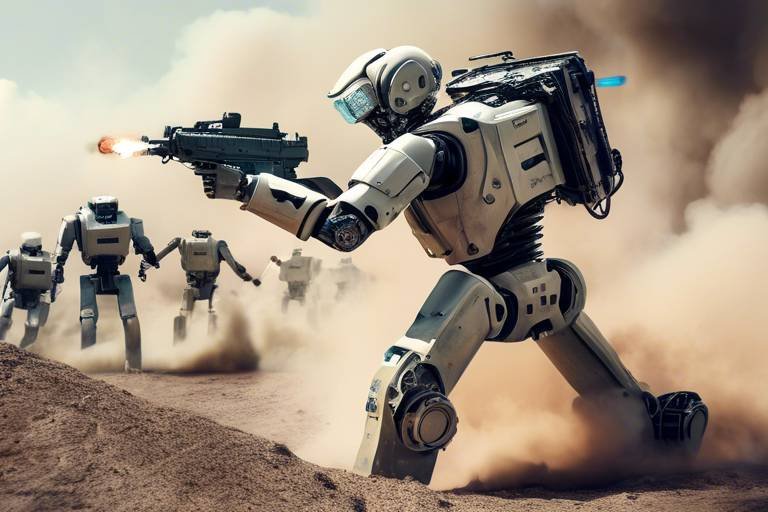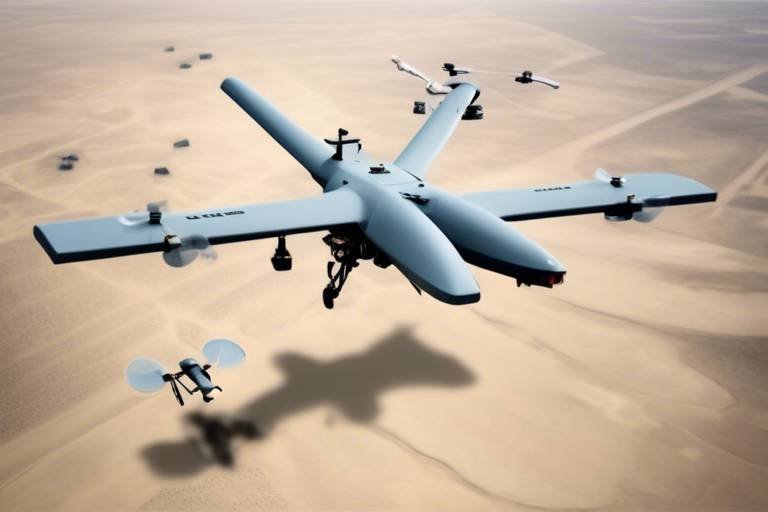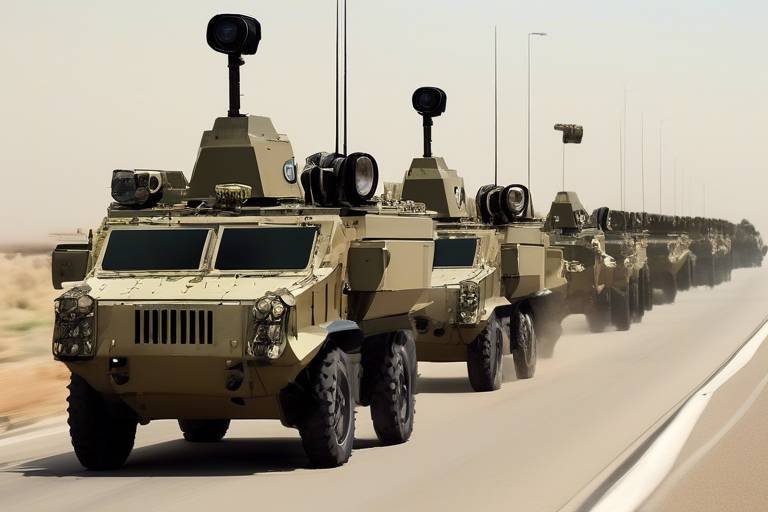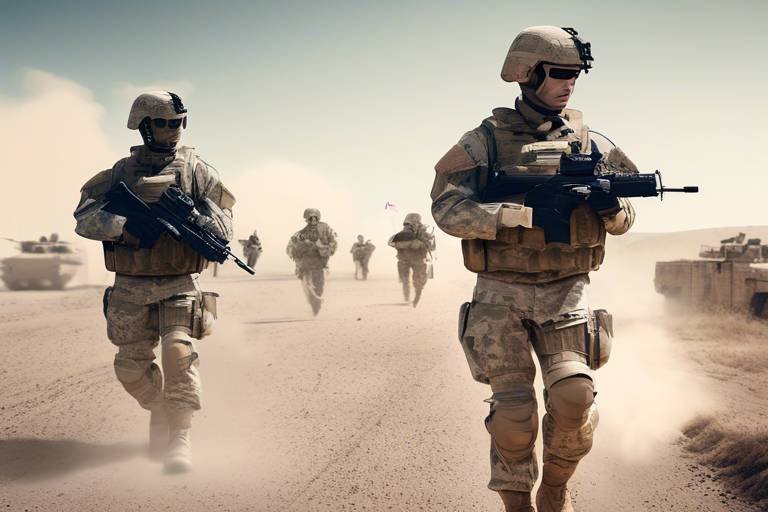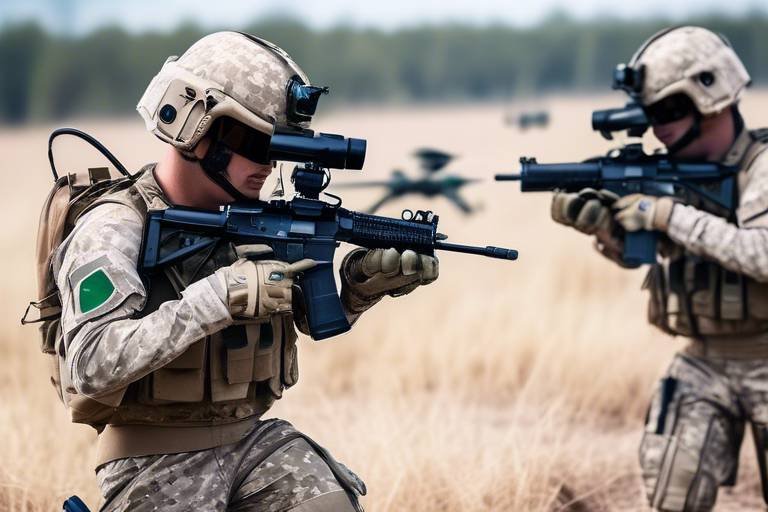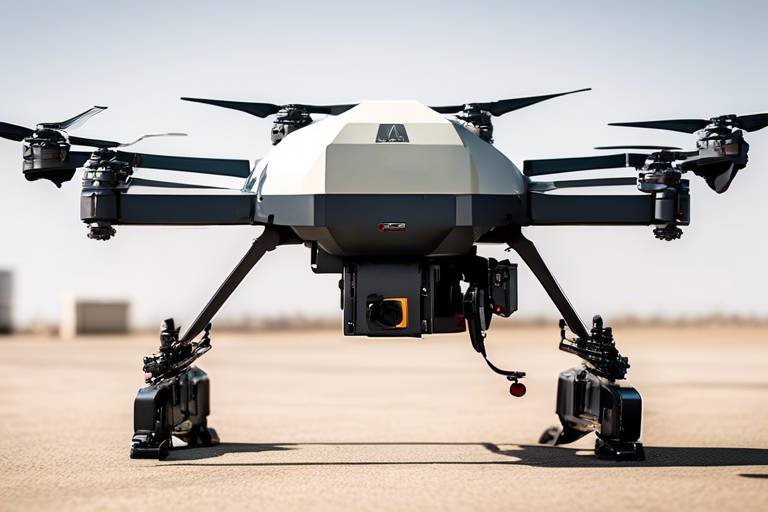How AI is Transforming Military Operations Management
The landscape of military operations is undergoing a seismic shift, and at the heart of this transformation is artificial intelligence (AI). Imagine a world where decisions are made not just on gut feelings or outdated information, but on real-time data and predictive analytics. This is not science fiction; it's the reality of modern military operations. AI is enhancing efficiency, decision-making, and strategic planning, making military forces more agile and effective than ever before. But how exactly is AI reshaping the way military operations are managed? Let's dive into the fascinating ways AI is revolutionizing the battlefield.
One of the most significant benefits of AI in military operations is its ability to enhance decision-making. With the sheer volume of information available today, commanders face the daunting task of sifting through data to make timely and informed choices. AI systems are stepping in to revolutionize this process by providing real-time data analysis and predictive insights. These systems can analyze vast amounts of data in seconds, offering commanders a clearer picture of the battlefield. Imagine having a trusted advisor who can process information faster than any human, identifying trends and potential threats before they become critical. This capability allows military leaders to act swiftly and effectively, ultimately saving lives and resources.
AI is not just about making better decisions; it’s also about improving operational efficiency. The integration of AI technologies in logistics and supply chain management is streamlining military operations in several ways:
- Reducing costs
- Improving resource allocation
- Enhancing overall operational effectiveness
These advancements are crucial in ensuring that military units can focus on their primary missions without being bogged down by logistical challenges.
One of the standout features of AI in logistics is automated logistics. This technology is transforming how military supplies are managed. With AI-driven automation, military units can ensure timely delivery and optimal inventory management. By leveraging predictive analytics and machine learning, these systems can forecast demand and adjust supply chains accordingly, preventing shortages or surpluses that could hinder operations. Picture a military supply chain that can predict the need for resources before they are even requested—this is the power of AI.
Another critical application of AI is in predictive maintenance. By utilizing AI, military units can anticipate equipment failures before they occur, significantly reducing downtime. This proactive approach ensures that critical assets are always operational and ready for deployment. Imagine a scenario where a tank or aircraft can signal its need for maintenance before a breakdown occurs—this not only saves time and money but also enhances mission readiness.
AI-powered smart inventory systems are also making waves in military operations. These systems facilitate precise tracking and management of supplies, allowing for more effective distribution and minimizing waste. With AI, military operations can maintain an accurate inventory, ensuring that the right supplies are available at the right time. This level of precision is vital in high-stakes environments where every second counts.
AI is reshaping military training programs as well. By providing personalized learning experiences and simulations that adapt to individual soldier needs, AI is improving readiness and effectiveness. Imagine a training program that evolves based on a soldier's performance, offering tailored challenges and scenarios to enhance their skills. This level of customization ensures that soldiers are better prepared for real-world situations, ultimately leading to more effective military operations.
When it comes to intelligence gathering, AI technologies are enhancing capabilities significantly. Military forces can analyze vast amounts of data for actionable insights and improved situational awareness. Advanced algorithms process and analyze intelligence data, identifying patterns and trends that inform strategic decisions. This ability to sift through mountains of data quickly is akin to having a supercharged analytical brain at the disposal of military strategists.
Advanced algorithms in AI are not just crunching numbers; they are identifying patterns and trends that can inform strategic decisions. This capability enhances operational planning and allows military leaders to foresee potential challenges before they arise.
AI-enhanced surveillance systems are another game-changer. They provide real-time monitoring and threat detection, enabling military units to respond swiftly to emerging situations. Think of these systems as a vigilant eye, constantly scanning for potential threats and alerting personnel before a situation escalates.
In today's digital age, cybersecurity is paramount, and AI plays a crucial role in bolstering military cybersecurity measures. AI can detect and mitigate threats faster than traditional methods, ensuring the integrity of sensitive information. This is especially important as military operations increasingly rely on digital infrastructure.
AI algorithms continuously analyze network traffic to identify anomalies and potential cyber threats. This proactive approach provides military organizations with defense mechanisms against cyber attacks, ensuring that their systems remain secure.
Automated incident response systems leverage AI to react swiftly to cyber threats. This capability minimizes damage and ensures rapid recovery from security breaches. In a world where cyber threats are ever-evolving, having AI on your side is like having a digital shield against potential attacks.
- How is AI improving military decision-making? AI provides real-time data analysis and predictive insights, enabling commanders to make informed choices quickly.
- What role does AI play in logistics? AI streamlines logistics by automating supply management and optimizing inventory, ensuring timely delivery of resources.
- Can AI enhance military training? Yes, AI personalizes training programs, adapting to individual soldier needs for improved readiness.
- How does AI improve cybersecurity in the military? AI detects and mitigates cyber threats faster, ensuring the integrity of sensitive information and rapid incident response.
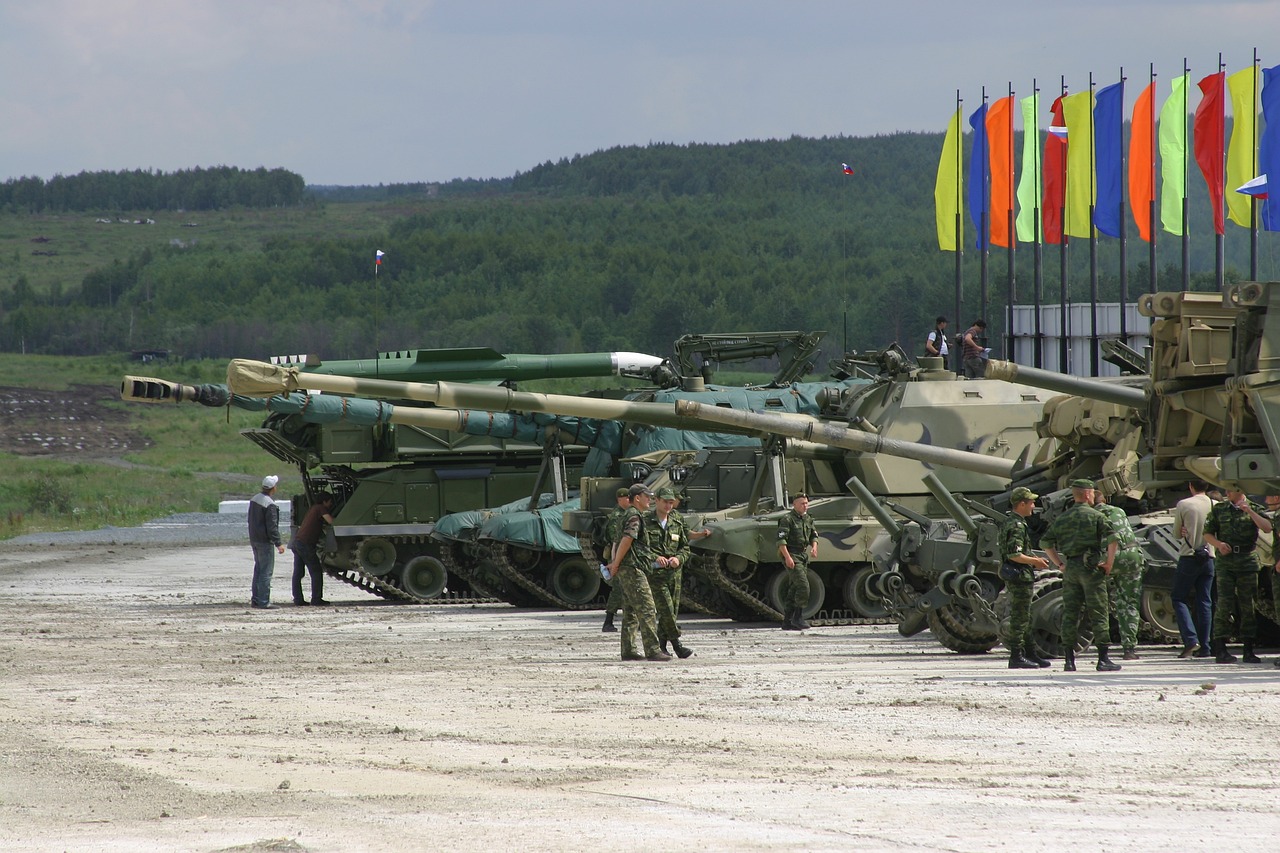
Enhanced Decision-Making
This article explores the significant ways artificial intelligence is reshaping military operations, enhancing efficiency, decision-making, and strategic planning through advanced technologies and innovative applications.
In the fast-paced world of military operations, decision-making is crucial, and AI is stepping in like a superhero to save the day. Imagine having a trusty sidekick that can analyze mountains of data in the blink of an eye—this is precisely what AI brings to the table. With its ability to process real-time data and provide predictive insights, AI is revolutionizing how commanders make decisions. Instead of relying solely on intuition or historical data, military leaders can now tap into advanced algorithms that sift through information faster than any human could.
For instance, during critical missions, commanders can access real-time analytics that highlight potential threats or opportunities based on current battlefield conditions. This means decisions can be made swiftly and effectively, reducing the chances of missteps that could jeopardize missions. By leveraging AI, military operations become more proactive rather than reactive, allowing forces to stay one step ahead of adversaries.
Moreover, AI systems can analyze past operations to identify patterns and outcomes, providing insights that inform future strategies. This predictive capability is akin to having a crystal ball; it empowers military leaders to foresee challenges and adjust their plans accordingly. Here’s how AI enhances decision-making:
- Data-Driven Insights: AI analyzes vast datasets to extract meaningful insights that human analysts might overlook.
- Scenario Simulation: Advanced simulations allow commanders to visualize potential outcomes before making decisions, weighing the pros and cons of various strategies.
- Risk Assessment: AI tools assess the risk levels associated with different courses of action, helping leaders choose the safest and most effective path forward.
Furthermore, AI can facilitate collaborative decision-making by providing a centralized platform where various military branches can share information and insights. This interconnectedness ensures that everyone is on the same page, reducing the chances of miscommunication during critical operations. The result? A more cohesive and efficient military force that can operate seamlessly across different domains.
In summary, AI is not just a tool; it’s a game-changer for military decision-making. By harnessing the power of AI, military leaders can make informed choices that enhance operational effectiveness, ultimately leading to successful missions and improved safety for personnel on the ground.
- How does AI improve military decision-making? AI enhances decision-making by providing real-time data analysis, predictive insights, and scenario simulations, allowing commanders to make informed choices quickly.
- What role does data play in AI-driven decision-making? Data is the backbone of AI systems; it enables algorithms to identify patterns and trends that inform strategic decisions in military operations.
- Can AI replace human decision-makers in the military? While AI significantly aids decision-making, it is designed to assist human leaders rather than replace them, ensuring that critical judgments still involve human expertise.
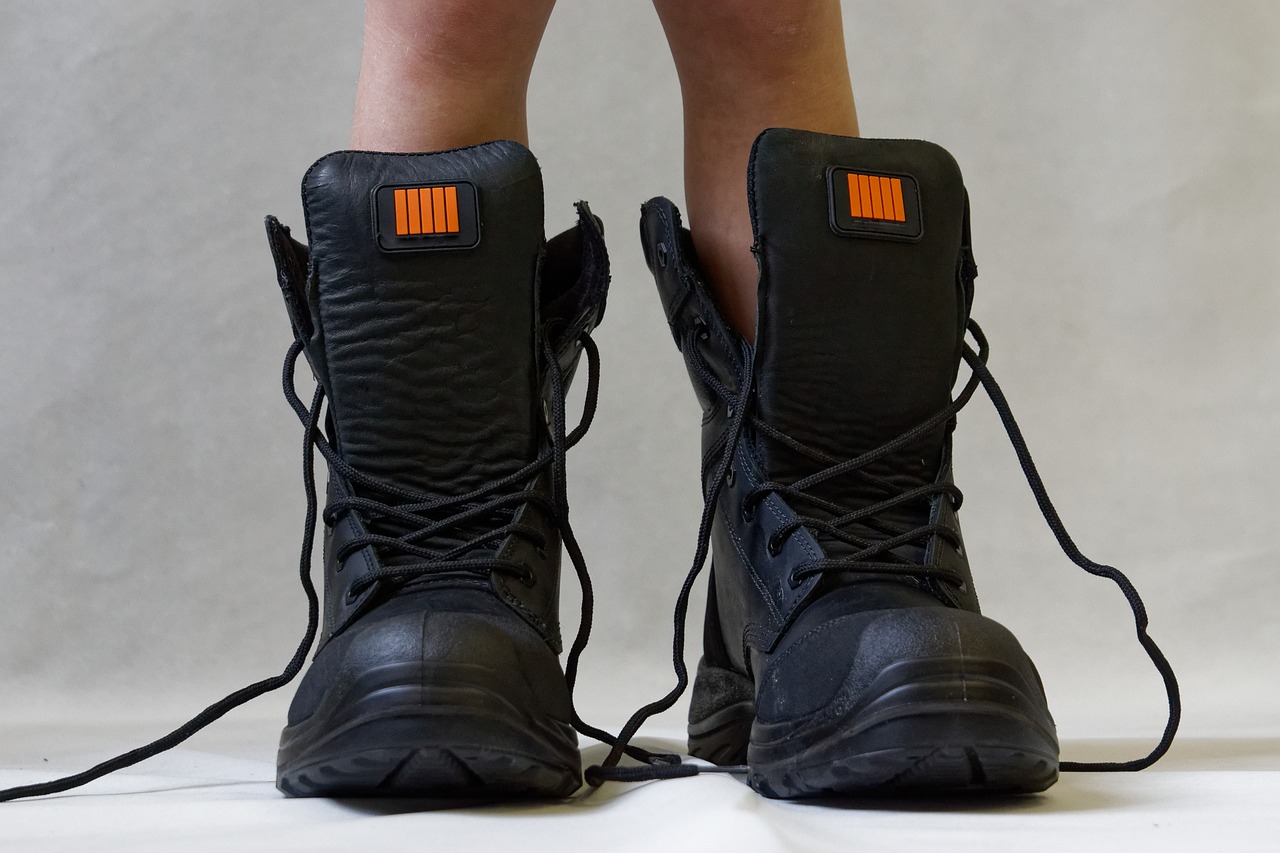
Operational Efficiency
In the fast-paced realm of military operations, is not just a goal; it's a necessity. The integration of artificial intelligence (AI) technologies is proving to be a game-changer, streamlining processes that were once bogged down by inefficiencies. Imagine a world where logistics and supply chain management operate like a well-oiled machine, reducing costs and improving resource allocation. That's the reality that AI is crafting for military forces around the globe.
One of the most significant transformations is in the area of automated logistics. Picture this: military supplies being managed with precision, ensuring timely deliveries without the clutter of human error. With predictive analytics and machine learning, AI can forecast supply needs, optimize routes, and even suggest the best times for resupply missions. This capability not only enhances operational efficiency but also allows commanders to focus on strategy rather than logistics.
Moreover, AI is taking on the role of a predictive maintenance guru. By utilizing advanced algorithms, military units can anticipate equipment failures before they occur. This proactive approach minimizes downtime, ensuring that critical assets are always operational and ready for deployment. Think of it as having a personal mechanic who knows your vehicle inside out, alerting you to potential issues before they become problematic.
Another fascinating aspect of AI's impact on operational efficiency is the advent of smart inventory systems. These AI-powered systems are designed to keep a finger on the pulse of military supplies, enabling precise tracking and management. With real-time data at their fingertips, military personnel can make informed decisions about distribution, reducing waste and ensuring that every resource is utilized effectively. Imagine knowing exactly what you have, what you need, and when you need it—this is the kind of clarity that AI brings to the table.
To sum it up, the integration of AI in military operations is not just about adopting new technologies; it's about revolutionizing the very fabric of how military forces operate. From automated logistics to predictive maintenance and smart inventory systems, AI is paving the way for a future where operational efficiency is maximized, costs are minimized, and commanders can focus on what truly matters—strategic planning and execution.
- How does AI improve logistics in military operations?
AI enhances logistics by automating supply chain management, optimizing delivery routes, and predicting supply needs, which leads to reduced costs and improved efficiency. - What is predictive maintenance and why is it important?
Predictive maintenance uses AI to anticipate equipment failures, allowing for timely repairs and minimizing downtime, ensuring that military assets are always ready for action. - What are smart inventory systems?
Smart inventory systems leverage AI for real-time tracking and management of supplies, helping military forces reduce waste and improve resource allocation.
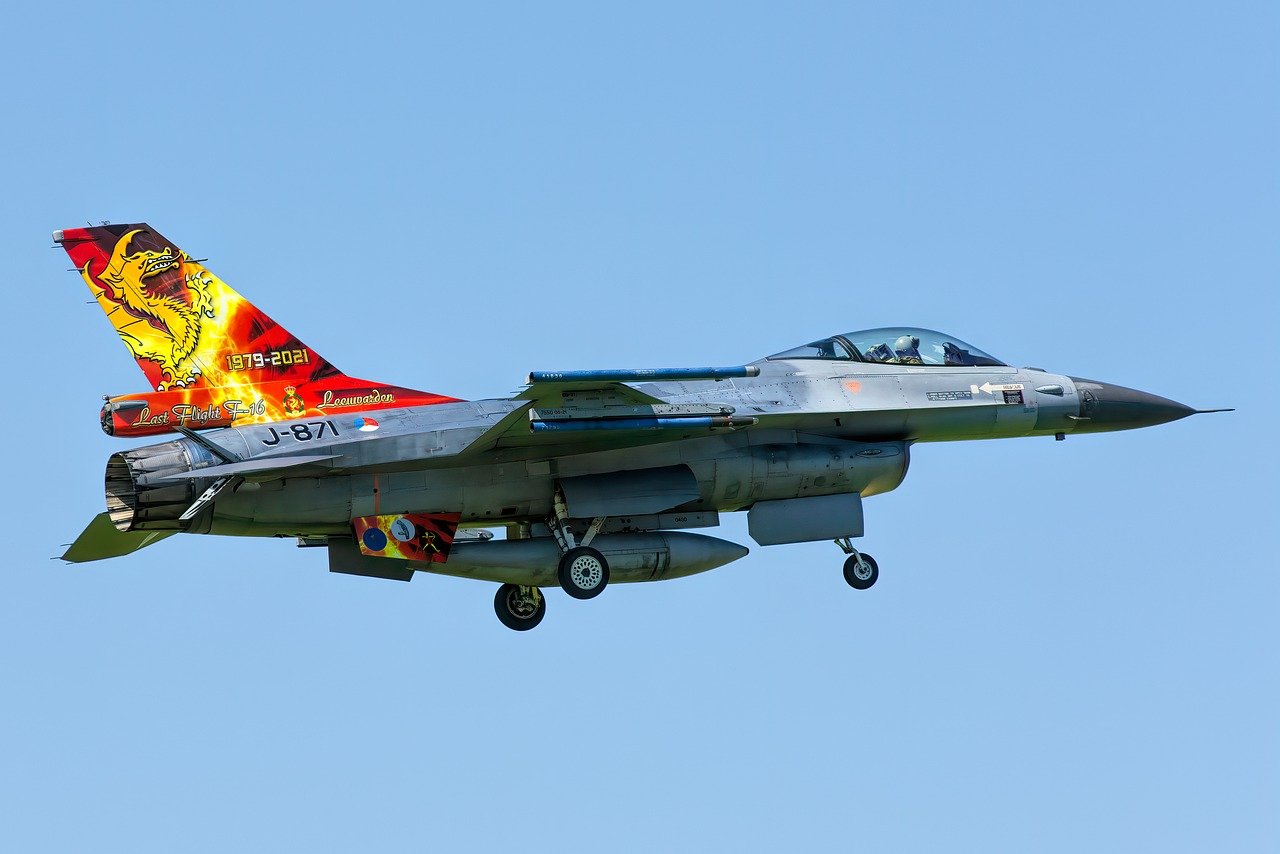
Automated Logistics
In the rapidly evolving landscape of military operations, stands out as a game changer. Imagine a world where military supplies are managed with the precision of a well-oiled machine, ensuring that troops are always equipped and ready for action. This is not just a dream; it's becoming a reality thanks to the integration of artificial intelligence (AI) into logistics systems. By harnessing the power of predictive analytics and machine learning, military organizations can optimize their supply chains like never before.
One of the most significant advantages of AI in logistics is its ability to predict demand and streamline inventory management. For instance, AI systems analyze historical data and current trends to forecast the necessary supplies for upcoming missions. This means that military units can avoid the pitfalls of overstocking or understocking essential materials. Instead of relying solely on human intuition, commanders can make data-driven decisions that enhance operational readiness.
To illustrate this, consider a scenario where a military unit is preparing for a large-scale operation. With AI-driven logistics, the system can automatically calculate the required ammunition, food supplies, and medical equipment based on the size and scope of the mission. This not only saves time but also ensures that every soldier has what they need, when they need it.
Moreover, the use of automated inventory systems allows for real-time tracking of supplies. Imagine a digital dashboard that provides instant updates on stock levels, location of materials, and even expiration dates of perishable items. This transparency is crucial for maintaining operational efficiency and minimizing waste.
The benefits of automated logistics extend beyond just inventory management. AI can also enhance the transportation aspect of military operations. By optimizing routes and schedules for supply delivery, AI systems can ensure that resources reach their destinations faster and more efficiently. This is particularly vital in conflict zones where every second counts and delays can have dire consequences.
In conclusion, the integration of AI into military logistics represents a significant leap forward in operational effectiveness. By automating and optimizing supply chain processes, military forces can enhance their readiness, reduce costs, and ultimately save lives. As we continue to embrace these technological advancements, the future of military logistics looks not only more efficient but also more secure.
- What is automated logistics?
Automated logistics refers to the use of technology, particularly artificial intelligence, to manage and optimize supply chain processes in military operations. This includes inventory management, transportation, and real-time tracking of supplies. - How does AI improve military logistics?
AI improves military logistics by providing predictive analytics that forecast supply needs, automating inventory management for real-time updates, and optimizing transportation routes for timely delivery. - What are the benefits of using AI in logistics?
The benefits include enhanced operational readiness, reduced costs, minimized waste, and improved decision-making capabilities, allowing military units to respond swiftly to changing conditions.
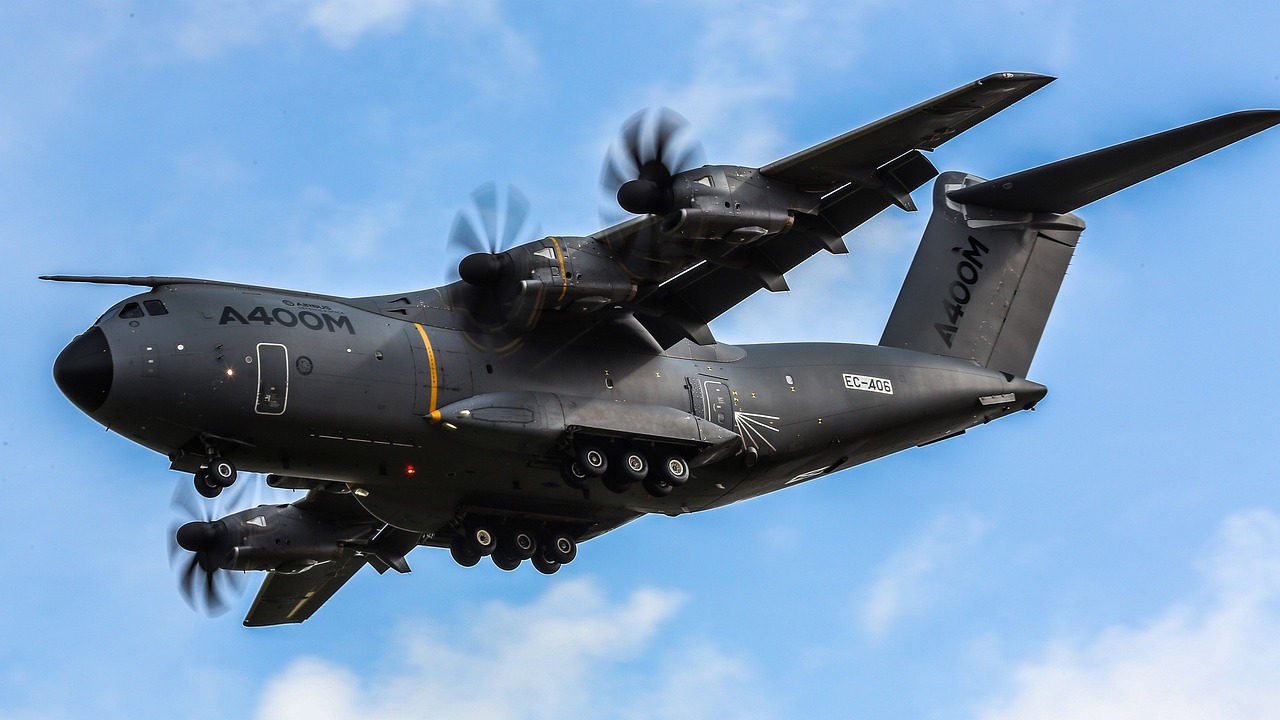
Predictive Maintenance
In the fast-paced world of military operations, has emerged as a game-changer. Imagine a soldier preparing for battle, knowing that their equipment is not just operational but also primed for peak performance. This is the power of AI-driven predictive maintenance. By harnessing advanced algorithms and machine learning, military units can anticipate equipment failures before they happen. This proactive approach not only minimizes downtime but also ensures that critical assets are always ready for deployment.
The essence of predictive maintenance lies in its ability to analyze vast amounts of data collected from various sensors embedded in military equipment. These sensors continuously monitor the health and performance of machinery, capturing everything from temperature fluctuations to vibration levels. By analyzing this data, AI systems can identify patterns that indicate potential failures. For instance, if a helicopter's rotor is vibrating abnormally, the system can flag this issue for immediate inspection, preventing a potential malfunction mid-flight.
The benefits of implementing predictive maintenance in military operations are profound. Here are a few key advantages:
- Cost Savings: By addressing maintenance issues before they escalate, military organizations can save significantly on repair costs.
- Increased Readiness: Ensuring that equipment is always in optimal condition means that military units can respond to crises without the worry of equipment failure.
- Enhanced Safety: Predictive maintenance reduces the risk of accidents caused by equipment malfunctions, protecting both personnel and assets.
Moreover, the integration of predictive maintenance creates a culture of proactive management within military organizations. Instead of waiting for a problem to arise, military leaders can focus on strategic planning and operational readiness. This shift not only improves the overall efficiency of military operations but also boosts morale among personnel, who can trust that they are equipped with reliable tools and machinery.
In conclusion, predictive maintenance is not just a technological innovation; it's a crucial element in modern military strategy. By leveraging AI to foresee and address equipment issues, military units can maintain a tactical advantage, ensuring that they are always prepared to face any challenge head-on.
- What is predictive maintenance? Predictive maintenance is a proactive maintenance strategy that uses data analysis and AI to predict when equipment will fail, allowing for timely interventions.
- How does AI contribute to predictive maintenance? AI analyzes data from sensors to identify patterns and anomalies that indicate potential equipment failures, enabling military units to take preventive action.
- What are the benefits of predictive maintenance in the military? Benefits include cost savings, increased equipment readiness, enhanced safety, and improved operational efficiency.
- Can predictive maintenance be applied to all military equipment? Yes, predictive maintenance can be applied to various military assets, including vehicles, aircraft, and communication systems.

Smart Inventory Systems
In the fast-paced world of military operations, the ability to efficiently manage resources can mean the difference between success and failure. Enter , a revolutionary approach powered by artificial intelligence. These systems leverage advanced technologies to facilitate precise tracking and management of military supplies. Imagine a scenario where every piece of equipment and every supply is monitored in real-time, ensuring that nothing goes missing and everything is where it should be. This level of efficiency not only streamlines operations but also minimizes waste, allowing military units to allocate their resources more effectively.
At the heart of smart inventory systems is the use of predictive analytics. By analyzing historical data and current trends, these systems can forecast future supply needs, ensuring that the right amount of resources is available at the right time. For instance, if a particular unit is expected to engage in a high-intensity operation, the system can automatically adjust inventory levels, ensuring that soldiers have everything they need when they need it. This capability is not just about efficiency; it’s about enhancing operational readiness.
Moreover, smart inventory systems can significantly reduce human error. Traditional inventory management often relies on manual counting and tracking, which can lead to discrepancies and shortages. With AI-driven systems, the potential for mistakes diminishes. These systems can continuously monitor stock levels and send alerts when supplies are running low, allowing for timely replenishment. This proactive approach ensures that military units are never caught off guard, ready to respond to any challenge that comes their way.
To illustrate the impact of smart inventory systems, consider the following table that outlines key benefits:
| Benefit | Description |
|---|---|
| Real-Time Tracking | Continuous monitoring of supplies to prevent shortages and overstocking. |
| Predictive Analytics | Forecasting future needs based on historical data and trends. |
| Reduced Human Error | Minimizing mistakes associated with manual inventory management. |
| Enhanced Operational Readiness | Ensuring that military units are always equipped and prepared for missions. |
In conclusion, smart inventory systems are not just a technological upgrade; they represent a fundamental shift in how military operations manage their resources. By harnessing the power of AI, these systems provide a level of efficiency and accuracy that was previously unattainable. As military forces continue to adapt to the complexities of modern warfare, the importance of smart inventory systems will only grow, ensuring that they remain agile and ready to tackle any challenge that comes their way.
- What are smart inventory systems? Smart inventory systems are AI-powered tools that track and manage military supplies in real-time, ensuring efficient resource allocation.
- How do predictive analytics work in inventory management? Predictive analytics analyze historical data to forecast future supply needs, helping to maintain optimal inventory levels.
- What are the benefits of using smart inventory systems? Benefits include real-time tracking, reduced human error, enhanced operational readiness, and overall improved efficiency.

Enhanced Training Programs
In today's fast-paced military landscape, traditional training methods are being transformed by the integration of artificial intelligence. This shift is not just a trend; it's a revolution that is reshaping how soldiers prepare for real-world scenarios. Imagine stepping into a training environment where every drill is tailored specifically for you, adapting in real-time to your strengths and weaknesses. That’s the power of AI in military training!
AI-driven training programs leverage personalized learning experiences to enhance soldier readiness. By analyzing performance data, these systems can identify areas where a soldier may need improvement, allowing for a more focused and effective training regimen. For example, if a soldier struggles with marksmanship, the AI can adjust the training modules to include more target practice and provide feedback on technique.
Moreover, the use of simulations powered by AI offers soldiers a chance to engage in realistic combat scenarios without the risks associated with live training exercises. These simulations can mimic various environments and conditions, from urban warfare to desert operations, providing a comprehensive training experience. Soldiers can practice decision-making under pressure, all while receiving instant feedback on their actions. This not only boosts confidence but also enhances critical thinking skills.
One of the standout features of AI-enhanced training programs is their ability to facilitate collaborative learning. Soldiers can engage in virtual environments where they can work together on missions, learning from one another while honing their skills. This collaboration fosters teamwork and communication, which are vital components in military operations.
As we look to the future, the potential for AI in military training seems limitless. With ongoing advancements in technology, we can expect even more sophisticated training tools that will continue to improve soldier performance and readiness. The question is, how far can we push the boundaries of training? With AI, the sky's the limit!
- How does AI personalize training for soldiers?
AI systems analyze individual performance data to tailor training programs that address specific needs, ensuring that each soldier receives the support they require. - What types of simulations are used in AI training?
AI-powered simulations can recreate various combat scenarios, allowing soldiers to practice decision-making and tactics in a safe, controlled environment. - Can AI improve teamwork during training?
Yes! AI facilitates collaborative training exercises that enhance communication and teamwork skills among soldiers.

Intelligence Gathering
In today's fast-paced world, has become a cornerstone of military effectiveness. With the vast amounts of data generated every second, traditional methods of data collection and analysis simply can't keep up. This is where artificial intelligence steps in, revolutionizing how military forces gather and interpret intelligence. By leveraging advanced algorithms and machine learning techniques, military organizations can now sift through mountains of data, identifying critical patterns and actionable insights that were previously hidden from view.
Imagine having a team of analysts who can process information at lightning speed, detecting anomalies and trends that would take humans weeks or even months to uncover. That's the power of AI in intelligence gathering. It allows military strategists to make informed decisions based on real-time data, enhancing situational awareness and operational planning. For instance, AI systems can analyze satellite imagery, social media feeds, and other sources of information to provide a comprehensive picture of the battlefield, enabling commanders to act swiftly and decisively.
Moreover, the integration of AI in intelligence operations doesn't just enhance speed; it also improves accuracy. Traditional intelligence methods often rely on human interpretation, which can be subjective and prone to error. In contrast, AI systems utilize data-driven approaches, reducing the likelihood of misinterpretation. This leads to more reliable intelligence, which is crucial for mission success. For example, AI can help identify potential threats by analyzing patterns in enemy movements, thereby allowing military units to preemptively address risks.
Additionally, AI technologies facilitate collaboration across different military branches and allied forces. By creating centralized databases that can be accessed in real-time, various units can share intelligence seamlessly, ensuring everyone is on the same page. This interconnectedness is vital for coordinated operations and enhances overall mission effectiveness.
To illustrate the transformative impact of AI on intelligence gathering, consider the following table that highlights key AI applications in military intelligence:
| AI Application | Description | Benefits |
|---|---|---|
| Data Mining | Extracting useful information from large datasets. | Improved decision-making and threat analysis. |
| Predictive Analytics | Using historical data to forecast future events. | Enhanced situational awareness and risk assessment. |
| Natural Language Processing | Analyzing human language data for sentiment and intent. | Better understanding of enemy communications. |
| Geospatial Analysis | Using AI to analyze geographical data. | Improved mapping and operational planning. |
In summary, the integration of AI in intelligence gathering is not just a trend; it's a fundamental shift in how military operations are conducted. By harnessing the power of advanced technologies, military forces can gain a competitive edge, ensuring they are always one step ahead of potential threats. As we continue to explore the capabilities of AI, it’s clear that the future of military intelligence is not only about collecting data but also about making sense of it in real-time, ultimately leading to more effective and efficient operations.
- How does AI improve intelligence gathering?
AI enhances intelligence gathering by processing vast amounts of data quickly, identifying patterns, and providing real-time insights that inform decision-making. - What are some applications of AI in military intelligence?
AI is used in data mining, predictive analytics, natural language processing, and geospatial analysis, among other applications. - Can AI replace human intelligence analysts?
While AI can significantly enhance the capabilities of human analysts, it is not intended to replace them. Instead, it serves as a powerful tool to augment their effectiveness. - How does AI affect the accuracy of intelligence?
AI reduces the likelihood of human error by using data-driven approaches, resulting in more accurate and reliable intelligence.

Data Analysis
In the fast-paced world of military operations, the ability to analyze data swiftly and accurately is nothing short of a game changer. AI technologies are stepping up to the plate, transforming how military forces process vast amounts of intelligence data. Imagine having a super-smart assistant that can sift through mountains of information in seconds, picking out the most relevant details to help commanders make informed decisions. This is precisely what AI-powered data analysis brings to the table.
Advanced algorithms are at the heart of this transformation. They don't just crunch numbers; they identify patterns and trends that might go unnoticed by human analysts. For instance, by examining historical data, these algorithms can predict potential threats or operational challenges that may arise in specific scenarios. It's like having a crystal ball that provides actionable insights to enhance strategic planning.
One of the most compelling aspects of AI in data analysis is its ability to integrate multiple data sources. Military operations generate data from various channels, including satellite imagery, reconnaissance reports, and social media feeds. AI systems can correlate this diverse information, offering a comprehensive view of the battlefield. This holistic approach enables commanders to understand the situation better, allowing for more effective tactical decisions.
Moreover, the speed at which AI processes data is crucial. In military operations, time is often of the essence. AI systems can deliver insights in real time, allowing military leaders to respond to emerging situations almost instantaneously. This capability can mean the difference between success and failure in critical missions.
To illustrate the significance of AI in data analysis, consider the following table that highlights the key benefits:
| Benefit | Description |
|---|---|
| Speed | AI processes data much faster than human analysts, enabling quicker decision-making. |
| Accuracy | Advanced algorithms reduce human error, providing more reliable insights. |
| Integration | AI can analyze data from multiple sources, offering a comprehensive view of operations. |
| Predictive Insights | AI identifies trends and potential threats, helping in proactive planning. |
In summary, the role of AI in data analysis is not just about crunching numbers; it's about empowering military decision-makers with the information they need to operate effectively in an increasingly complex environment. As AI continues to evolve, its impact on military operations will only grow, leading to more informed strategies and successful outcomes.
- How does AI improve military decision-making?
AI enhances decision-making by providing real-time data analysis and predictive insights, allowing commanders to make informed choices quickly and effectively.
- What are the benefits of AI in logistics?
AI streamlines logistics by automating processes, improving resource allocation, and ensuring timely delivery of supplies.
- Can AI predict equipment failures?
Yes, AI can anticipate equipment failures through predictive maintenance, reducing downtime and ensuring operational readiness.
- How does AI enhance intelligence gathering?
AI analyzes vast amounts of data to identify patterns and trends, improving situational awareness and informing strategic decisions.

Surveillance Systems
In the fast-paced world of military operations, powered by artificial intelligence are proving to be game-changers. Imagine having a watchful eye that never blinks, constantly analyzing the environment and providing real-time data to military commanders. This is precisely what AI-enhanced surveillance systems offer. They utilize advanced algorithms and machine learning to process data from various sources, including drones, satellites, and ground sensors, to detect potential threats and monitor activities in real-time.
One of the most remarkable aspects of these systems is their ability to sift through vast amounts of data almost instantaneously. Traditional surveillance methods often require human analysts to comb through hours of footage or data logs, which can lead to delays in response times. However, AI systems can analyze this information in seconds, highlighting anomalies and potential threats that warrant immediate attention. This efficiency not only saves time but also enhances the overall situational awareness of military units on the ground.
Moreover, these systems are equipped with predictive analytics, enabling them to forecast potential threats based on historical data. For instance, if a particular area has a history of hostile activity, the AI can flag it for closer monitoring, allowing military personnel to allocate resources more effectively. This proactive approach to surveillance ensures that troops are always one step ahead, ready to respond to any emerging situation.
Additionally, the integration of AI in surveillance systems allows for automated threat detection. These systems can identify and categorize various types of threats, from unauthorized personnel to potential vehicle incursions, without the need for constant human oversight. This not only reduces the cognitive load on military personnel but also minimizes the risk of human error, which can be critical during high-stakes operations.
To illustrate the impact of AI in surveillance, consider the following table that outlines the key features and benefits of AI-enhanced surveillance systems:
| Feature | Benefit |
|---|---|
| Real-time Data Processing | Instantaneous threat detection and response |
| Predictive Analytics | Proactive threat identification and resource allocation |
| Automated Monitoring | Reduced cognitive load and minimized human error |
| Integration with Multiple Data Sources | Comprehensive situational awareness |
In summary, AI-enhanced surveillance systems are revolutionizing how military operations are conducted. By providing real-time insights, predictive capabilities, and automated monitoring, these systems empower military personnel to make informed decisions swiftly and effectively. The result is a more agile and responsive military force, capable of addressing threats before they escalate. With the continuous evolution of AI technology, the future of military surveillance looks promising, paving the way for enhanced security and operational success.
- What are AI-enhanced surveillance systems?
AI-enhanced surveillance systems use artificial intelligence to analyze data from various sources in real-time, enabling military forces to detect threats and monitor situations effectively. - How do these systems improve situational awareness?
By processing large amounts of data quickly and providing actionable insights, AI systems enhance situational awareness, allowing military personnel to respond to threats more effectively. - Can AI surveillance systems operate autonomously?
Yes, many AI surveillance systems are designed to operate autonomously, allowing them to monitor environments continuously without constant human oversight. - What are the benefits of predictive analytics in surveillance?
Predictive analytics helps identify potential threats based on historical data, allowing military units to allocate resources effectively and enhance their readiness.

Cybersecurity Enhancements
In today's digital battlefield, where information is as crucial as weaponry, AI plays a pivotal role in enhancing military cybersecurity. With the increasing sophistication of cyber threats, traditional defense mechanisms are often too slow to keep up. Enter AI: a game-changer that can analyze and respond to threats in real-time, ensuring that sensitive information remains secure. Imagine a vigilant guard dog that never sleeps; that's AI for military cybersecurity.
One of the most significant advantages of AI in this arena is its ability to detect threats before they escalate. AI algorithms continuously monitor network traffic, scanning for anomalies that could indicate a cyber attack. This proactive approach is akin to having a smoke detector that alerts you to danger before a fire breaks out. With AI's advanced data analysis capabilities, military organizations can identify potential vulnerabilities and address them swiftly, minimizing the risk of breaches.
Furthermore, incident response is another area where AI shines. When a cyber threat is detected, AI can automate the response process, allowing for rapid action that human operators may not be able to achieve. This automation can significantly reduce the time it takes to mitigate a threat, akin to having a fire extinguisher ready and operational at the first sign of flames. By leveraging AI for incident response, military units can recover quickly from security breaches, ensuring that operations continue smoothly.
To illustrate the impact of AI in military cybersecurity, consider the following table that highlights key enhancements:
| Enhancement | Description | Benefit |
|---|---|---|
| Threat Detection | Continuous monitoring of network traffic for anomalies | Proactive defense against potential cyber attacks |
| Incident Response | Automated systems that react to detected threats | Rapid mitigation of damage and recovery from breaches |
| Data Analysis | Advanced algorithms analyzing vast datasets | Informed decision-making and strategic planning |
In conclusion, the integration of AI into military cybersecurity is not just an option; it's a necessity in an era where cyber threats are omnipresent. By enhancing threat detection and incident response capabilities, AI ensures that military operations remain secure and effective. As we continue to navigate this digital age, the military's reliance on AI for cybersecurity will only grow stronger, paving the way for a more resilient defense strategy.
- What role does AI play in military cybersecurity? AI enhances threat detection and incident response, allowing for quicker and more effective mitigation of cyber threats.
- How does AI improve threat detection? AI continuously monitors network traffic for anomalies, identifying potential threats before they escalate.
- Can AI fully replace human cybersecurity experts? While AI can automate many processes, human oversight is still crucial for strategic decision-making and complex problem-solving.

Threat Detection
In today's digital battlefield, where information is both a weapon and a target, AI algorithms have become indispensable in the realm of . These sophisticated systems continuously analyze network traffic, identifying anomalies that could indicate potential cyber threats. Imagine having a vigilant guard that never tires, constantly scanning for intruders in a vast digital landscape—this is the essence of AI in cybersecurity. By leveraging machine learning, these algorithms learn from previous attacks, adapting and evolving to recognize new patterns of malicious behavior.
One of the remarkable features of AI-driven threat detection is its ability to process vast amounts of data in real-time. Traditional methods, reliant on human intervention, often fall short in speed and efficiency. In contrast, AI can sift through terabytes of data, flagging suspicious activities within seconds. This capability not only enhances the speed of detection but also significantly reduces the likelihood of false positives, which can overwhelm cybersecurity teams. In essence, AI acts as a smart filter, allowing human analysts to focus on genuine threats instead of sifting through endless alerts.
Moreover, AI systems utilize advanced anomaly detection techniques that analyze baseline behaviors within a network. By establishing what is "normal," these systems can quickly identify deviations that may signify a breach or an attack. For instance, if a user typically accesses certain files during business hours but suddenly attempts to access sensitive data in the middle of the night, the AI system can flag this behavior for further investigation. This proactive approach not only enhances security but also helps in maintaining the integrity of sensitive information.
To illustrate the effectiveness of AI in threat detection, consider the following table that compares traditional methods with AI-enhanced systems:
| Feature | Traditional Methods | AI-Enhanced Systems |
|---|---|---|
| Data Processing Speed | Slow, often requiring manual review | Real-time analysis of vast datasets |
| False Positives | High, leading to alert fatigue | Low, with advanced filtering techniques |
| Adaptability | Static, requires manual updates | Dynamic, learns from new threats |
| Response Time | Delayed, often reactive | Immediate, with automated responses |
In summary, the integration of AI into threat detection not only enhances the speed and accuracy of identifying potential cyber threats but also revolutionizes how military organizations approach cybersecurity. By automating the detection process, military units can allocate resources more effectively, allowing human analysts to concentrate on strategic decision-making rather than getting bogged down by manual data analysis. With AI on their side, they are better equipped to defend against the evolving landscape of cyber threats, ensuring a secure environment for their operations.
- How does AI improve threat detection in military cybersecurity?
AI improves threat detection by analyzing vast amounts of data in real-time, identifying anomalies, and learning from previous attacks to adapt to new threats. - What are the benefits of using AI for threat detection?
Benefits include faster detection speeds, reduced false positives, dynamic adaptability, and automated responses, which enhance overall cybersecurity. - Can AI completely replace human analysts in cybersecurity?
No, while AI significantly enhances threat detection, human analysts are essential for strategic decision-making and handling complex situations.

Incident Response
In the rapidly evolving landscape of military operations, has become a critical component in maintaining security and operational integrity. With the increasing sophistication of cyber threats, military organizations are turning to artificial intelligence to enhance their response capabilities. AI-driven incident response systems are designed to react swiftly and effectively to potential cyber threats, minimizing damage and ensuring rapid recovery from any security breaches.
One of the key advantages of AI in incident response is its ability to analyze vast amounts of data in real-time. Traditional methods often struggle to keep pace with the speed and volume of cyber attacks, but AI algorithms can continuously monitor network traffic, identifying anomalies that may indicate a breach. This proactive approach allows military units to detect threats before they escalate into full-blown incidents.
Moreover, AI-powered systems can automate many of the initial response actions. For example, once a threat is detected, the system can initiate predefined protocols, such as isolating affected systems, alerting personnel, and even deploying countermeasures. This automation not only speeds up the response time but also reduces the likelihood of human error, which can be critical during high-pressure situations.
To illustrate the effectiveness of AI in incident response, consider the following table that highlights the comparison between traditional methods and AI-enhanced systems:
| Aspect | Traditional Methods | AI-Enhanced Systems |
|---|---|---|
| Response Time | Slower, often reactive | Instantaneous, proactive |
| Data Analysis | Manual and time-consuming | Real-time and automated |
| Human Error | High potential for mistakes | Minimized through automation |
| Adaptability | Rigid protocols | Learning algorithms that adapt |
Furthermore, the integration of AI into incident response not only enhances the immediate reaction to threats but also contributes to ongoing learning and improvement. AI systems can analyze the outcomes of past incidents, identifying what worked and what didn’t. This feedback loop allows military organizations to refine their strategies continually, making them more resilient against future attacks.
In conclusion, the deployment of AI in incident response is transforming how military organizations safeguard their operations from cyber threats. By leveraging advanced technologies for rapid detection, automated responses, and continuous learning, military units can maintain a robust defense posture, ensuring that they are always prepared to tackle the challenges of the digital battlefield.
- What is incident response in military operations?
Incident response refers to the processes and strategies employed by military organizations to detect, respond to, and recover from cyber threats and security breaches.
- How does AI improve incident response?
AI enhances incident response by providing real-time data analysis, automating response actions, and minimizing human error, allowing for quicker and more effective threat management.
- What are the main benefits of AI in cybersecurity?
The main benefits include faster detection of threats, automated incident responses, reduced response times, and improved adaptability to emerging threats through continuous learning.
- Can AI completely replace human involvement in incident response?
While AI significantly enhances incident response capabilities, human oversight is still crucial for strategic decision-making and handling complex situations that require nuanced judgment.
Frequently Asked Questions
- How is AI enhancing decision-making in military operations?
AI enhances decision-making by providing real-time data analysis and predictive insights. This allows commanders to make informed choices quickly, ensuring that military operations are efficient and effective.
- What role does AI play in operational efficiency?
AI optimizes logistics and supply chain management, reducing costs and improving resource allocation. By automating processes, AI ensures that military operations run smoothly and effectively.
- Can you explain automated logistics?
Automated logistics uses AI to manage military supplies, ensuring timely delivery and optimal inventory management. Predictive analytics and machine learning play key roles in streamlining these processes.
- What is predictive maintenance and why is it important?
Predictive maintenance involves using AI to foresee equipment failures before they happen. This reduces downtime and keeps critical assets operational, which is vital for military readiness.
- How does AI improve military training programs?
AI personalizes training experiences by adapting simulations to individual soldier needs. This tailored approach enhances readiness and effectiveness, ensuring that soldiers are well-prepared for their roles.
- In what ways does AI enhance intelligence gathering?
AI improves intelligence gathering by analyzing vast amounts of data for actionable insights. Advanced algorithms identify patterns and trends, which inform strategic decisions and enhance situational awareness.
- What are AI-enhanced surveillance systems?
AI-enhanced surveillance systems provide real-time monitoring and threat detection. This capability allows military units to respond quickly to emerging situations, maintaining security and safety.
- How does AI contribute to cybersecurity in military operations?
AI strengthens cybersecurity by detecting and mitigating threats more swiftly than traditional methods. It ensures the integrity of sensitive information, which is crucial for national security.
- What is the significance of threat detection using AI?
AI algorithms continuously analyze network traffic to find anomalies and potential cyber threats. This proactive approach helps military organizations defend against cyber attacks effectively.
- How does AI assist in incident response?
Automated incident response systems utilize AI to react quickly to cyber threats. This minimizes damage and ensures rapid recovery from security breaches, keeping military operations secure.


